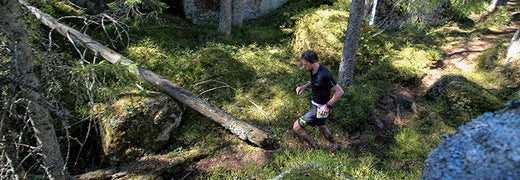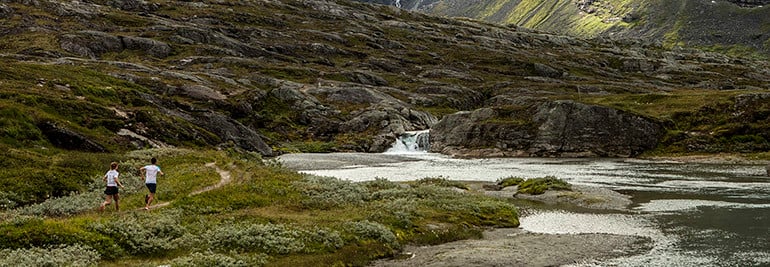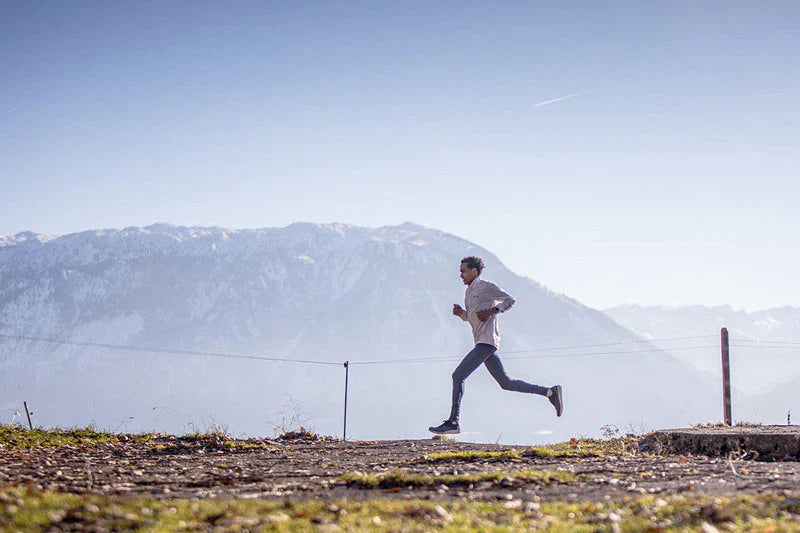

Suunto Blog

Who climbs the most? Suunto World Vertical Week 2018 big data is here
WHICH COUNTRY CLIMBS THE MOST?
No big surprises here. The Austrians took the top spot again by a clear margin: on average they climbed almost a hundred meters higher than any other nation. Congratulations!
Also Switzerland was once again very strong: they have placed in the top three in the World Vertical Week ranking every year.
Overall the top four was dominated by people living in countries with the Alps. The popularity of ski touring, once again the activity with the most average ascent, surely contributes to these countries’ ranking.
Which country climbs the most? (average ascent per activity, top 20 countries)
Austria 472 m
Switzerland 375 m
Italy 360 m
Slovenia 338 m
Slovakia 281 m
Spain 263 m
Norway 255 m
France 250 m
Portugal 229 m
Germany 222 m
The Czech Republic 210 m
Mexico 189 m
South Africa 177 m
Singapore 176 m
Canada 170 m
New Zealand 169 m
The United States 167 m
Hungary 161 m
Republic of Korea 151 m
Sweden 150 m
BUT WHAT ABOUT THE DIFFERENT ACTIVITIES? WHO CLIMBS THE MOST?
We tracked all human-powered outdoor sports and looked at eight of them more closely: running, trail running, trekking, mountaineering, cycling, mountain biking, ski touring and cross-country skiing. A special shout-out goes to Japan and Italy: they both were on top in two different activity rankings. Italy even managed to get six top fives out of eight possible ones.
Skiers climbed away from the others also this year with the highest average ascent per activity (867 m). Also the number two, mountaineering with 688 m on average, kept its spot. Trail running (380 m) defended its third spot even though the trail runners didn’t reach the 400-meter mark this year.
To keep the playing field level, we were only comparing averages. A cumulative number of ascent meters per country or activity would not have made sense as the population and number of Suunto members varies from nation to nation.
YOU DON’T NEED MOUNTAINS AT HOME TO ENJOY BIG ASCENTS
The biggest surprise this year was the winner in ski touring category: the skiers from the Netherlands toured the biggest average ascents! It seems you don’t need mountains to enjoy big ascents. The highest point of their country rises only to 322 meters.
However, it is hard to believe that the Dutch would have collected all that vert back at home. One explanation for their success is that they didn’t actually tour at home, but had mostly traveled on a holiday to bigger hills and had had time to really record some vert. The same must be partly true to Great Britain that took the second spot in the ski touring ranking.
Countries like Switzerland, Austria, Italy and France had tens of times more ski touring activities during the week than the Dutch or the Brits but their averages were still lower. It seems that it is hard to beat someone enjoying a holiday even if you have mountains in your backyard. More dawn patrols and headlamp tours will be needed for the locals if they wish to beat their guests next year!
This analysis is not meant to take anything away from the Dutch and the Brits. There seems to be an active ski touring community in both countries that know that you need to go out during the World Vertical Week! Good job!
Ski touring (average 867 m)
The Netherlands 1160 m
Great Britain 1130 m
Switzerland 996 m
Spain 953 m
Italy 951 m
JAPANESE ON TOP IN MOUNTAINEERING
Japanese mountaineers recorded the highest average ascents during the week-long event. They added about 150 meters to their last year’s average and went from fifth to first. Well done!
Mountaineering (average 688 m)
Japan 846 m
Switzerland 799 m
Italy 765 m
Austria 746 m
France 743 m
ASIA DOMINATED TRAIL RUNNING DURING THE WORLD VERTICAL WEEK
It has been clear every year that Asia is strong in trail running and the same trend continues also this time around: The crown for the most average trail running ascent goes to Japan! That’s a strong performance considering the Japanese were number one also in mountaineering. Top spots in mountaineering and trail running, activities with the second and the third biggest average ascents, is an excellent demonstration that the Japanese are really strong in the uphill.
Winter in the mountainous regions in Europe and North America may limit the trail running ascents but never the less the Japanese and Chinese runners were very strong.
Trail running (average 380 m)
Japan 731 m
China 653 m
Portugal 547 m
Italy 523 m
Spain 508 m
Mountain biking (average 323 m)
Italy 482 m
Spain 479 m
South Africa 382 m
New Zealand 378 m
Brazil 377 m
Trekking (average 315 m)
Italy 436 m
Austria 426 m
France 357 m
Spain 354 m
USA 246 m
Cycling (average 214 m)
Spain 411 m
Italy 363 m
South Africa 328 m
France 301 m
Austria 264 m
Cross-country skiing (average 199 m)
The Czech Republic 374 m
France 316 m
Norway 259 m
Austria 219 m
Sweden 213 m
Running (average 103 m)
Slovenia 192 m
Norway 151 m
Switzerland 146 m
Croatia 142 m
Portugal 139 m
READ ALSO: THREE INSPIRING STORIES FROM SUUNTO WORLD VERTICAL WEEK

Congratulations to the Suunto Summit 2018 selections!
The 2018 Suunto Summiteers are:
Aniol, Spain
Daniel, Switzerland / Spain
Dmytro, Ukraine
Julia, Finland
Leonardo, Italy
Maggie, UK
Patrick, France
Patrik, Slovakia
Sherry, USA
Tara, USA
Teoh, Malaysia
Valentin, Romania
Verónica, Ecuador
(All participants have been individually contacted by Suunto.)
Welcome to #suuntosummit, everyone!
***** 5 February 2018 *****
Suunto Summit 2018
Do you want to be a part of a weekend full of trail running in the Finnish forest, workshops on Suunto products, and a little sauna too? If you can get to Helsinki for 4-6.5, we’ll do the rest!If this sounds like your kind of weekend, fill in the application below and tell us why you’re passionate about sports and Suunto, and share your story with #suuntosummit
Applications are due by 22.2.2018. (Amer Sports employees are not eligible for this Suunto Summit)
APPLY NOW
Here's what the Summit looks like in action!
In 2017 we hosted an inspiring group of 16 Suunto fans from around the world for a weekend of sharing experiences – and some muddy Finnish trails.
Summit team gearing up for the start of the trail race
Serene moment for Sante in the forest
Ready for orienteering?
Summiteers celebrating at the finish of Bodom Trail
All images by Philipp Reiter

Three inspiring stories from Suunto World Vertical Week 2018
Kat Schjei, California, USA
Feeling inspired by @suunto #verticalweek ; in the last seven days I have climbed over 5,000 feet either wearing this adventurous toddler, or pushing him in the stroller. It isn't easy, but I thrive on the challenge and seek more adventures with my sidekick every day. 🗻 #verticalweek #noexcuses #motherrunner #BAMR #BAMRbassador #runitfast #irunhesleeps #saltymountainmamas #getsalty #trailrunner #ultrarunners #trailchix #lasthorse #r4twc #running4thosewhocant #nomeatathlete #ultrarunner
A post shared by Kat Schjei (@smushtush) on Mar 1, 2018 at 6:15pm PST
“I live in Southern California but have lived all over the US. I'm a mom of three small kids and work as a nurse at the children's hospital, but that doesn't stop me from exploring and climbing as much as possible.
I'm currently training for my fourth 100-mile race, the Tahoe Rim Trail 100, which is located on some of my favorite peaks to climb. My Vertical Week was fun! I strapped my youngest son on my back and we climbed around 1500 feet a day, which is a crazy hard strength workout with his added weight. He loves taking in the sights as much as I do, and I know this is great race training because the added weight feels like double the distance.
I'm very much an advocate for getting kids outside; my three have learned to fall in love with the beauty that is rewarded when you put effort into a steep climb. I live my life to lead them and other families by example.”
Anna Persson, Norway
Added 4000m to my vertical weekend today! It felt like 1000 😁 #verticalweek #timetoplay #romsdalen #uterauma #suunto 's #week #mountains #outdoorlife #training #sun #winter
A post shared by Anna Persson (@anna_persson_) on Mar 2, 2018 at 11:23am PST
“I came to Norway 12 years ago. A summer job made me come here and nature has kept me here. The nature of Rauma in Romsdalen, Norway is spectacular with its many high and steep mountains by the sea. The mountains are in my backyard so I can walk to them from my front door.
My favorite training mountain in winter time is 1439-meter-high Kyrkjetaket – and the mountains around it. I often climb it two or three times before I go to work in the afternoon. The same mountain feels different every day. Snow and weather conditions may vary from day to day but when I`m at the top, it’s always the same; magical, wonderful feeling of freedom.
My #verticalweek was pretty hectic because of work. I also caught a cold. Luckily the snow and weather conditions were perfect this week so it was easy for me to do some vertical meters every day.”
Hannes Gehring, Colorado, USA
It’s been nearly 7 months since I’ve raced. Following my last race I found myself fighting demons, questioning and challenging my dreams and pursuits in ultra-running. I ballooned from a race weight of 168 to 206 lbs by mid December. It has been snail-crawl back to fitness but my focus has never been more deliberate. Yesterday’s 24 miles and 7,000 feet of climbing capped the week at 100 miles and 20k of vertical gain and felt like an unleashing of a few months worth of frustration, angst, and doubt. Sometimes following your passion, your crazy, and your heart is the only way to dig out of that hole you’re in. I’ve been digging for a few months. I’m back and there’s a fire 🔥🔥🔥coursing through my veins. (📷 Yesterday circa my 41,288th step 📸captured here by ninja photographer @itsmarincita) #uphillswagger
A post shared by Hannes Gehring (@uphillswagger) on Mar 5, 2018 at 10:46am PST
“Last March I decided to pursue ultra-running full time and moved into my truck with my two rescue dogs. They are the reason I found mountains; once I had rescued my first dog he led me to trails and helped me find my passion in mountain running.
Suunto's Vertical week went great for me. I was fortunate enough to climb over 20,000 vertical feet and cover over 100 miles, including a summit of the 14,035' Mt. Sherman here in Colorado.
I think any climb that gains 4,000 feet or more feels like a really burly climb. Typically, for my big days I aim for over 10,000 feet of uphill climbing. The steeper the better as far as I am concerned!
Ultra-running is my biggest passion (other than my dogs). So, my biggest motivation when a climb gets tough is that I want to do this professionally at the highest level. It keeps me humble and hungry grinding up a steep trail, knowing my dreams are lofty, but attainable – if I just keep pushing up that hill. Plus, my dogs make every climb look like it's a cake walk and that's a humbling motivator as well!”
Congratulations, Kat, Anna and Hannes! Your new Suunto Spartan Sport Wrist HR Baro watches are on their way to you.
And a big thank you to everyone who participated in Suunto World Vertical Week and shared photos and stories. Happy adventures to you all – both in the ups and downs!
LEARN MORE ABOUT SUUNTO WORLD VERTICAL WEEK 2018
Vertical Week 2018
Now is the time to celebrate both the suffering and the flying. Welcome to the third annual Vertical Week!
Vertical Week 2018 starts on Monday, February 26 and ends on Sunday, March 4. Put on your running shoes, hop on your bike or release your heels and start skinning up the hill.
Track your adventures with your Suunto watch, sync with Suunto App, and by the end of the week we’ll know which country climbs the most in a week.
Every move counts!
Share your Vertical Week experiences on Instagram or Facebook with #VerticalWeek. Three of the most inspiring posts will win Suunto Spartan Sport Wrist HR Baro watches.
Terms and conditions apply. Read them here.

This retiree climbed 2 million height meters – and recorded every single one on his Suunto
Over at Suunto, we make our products to stand the test of time – but even we can’t demonstrate that as well as Walter Hassler, from Tirol, Austria. The retiree has taken his Suunto X6 on every single bike, ski tour, and hike since he got it thirteen years ago – and it’s still ticking, all the way up to two million height meters (now, more.) We stopped by for a visit to see what we could learn about him – and his thirst for adventure.
As a young man my goal was getting faster and faster
Now I am just happy to keep doing what I am doing. I grew up with nine siblings in the beautiful valley of Zillertal. Sports has always been important for us – I played soccer, biked, went swimming or skiing with my brothers and sisters. Now it’s mostly mountain biking and ski touring. On good days I am still able to achieve the same results (time) as 13 years ago when I first got my Suunto watch.
12 ski/bike tours a month are the minimum
If the weather is nice I sometimes do up to 15 tours a month in summer.I don’t get on my bike (or my skis) for less than 1,000 height meters
This is how I end up doing between 15,000 and 20,000 height meters a month on average. Whenever I am on my bike I am clocking between 2.5-3 hours minimum. The longest tours I am doing are up to 6 hours though. Of course I feel bad for my wife, leaving her alone for a couple hours every other day!
On October 24th, 2009 I put 1 million height meters on to my Suunto
When I downloaded the data 4 days later I already had 1,007,000 height meters on it. I wanted to put 2 million height meters on, and then stop – at least that´s what I said. When I downloaded the data it was already 2,007,000 height meters, so I just have to keep going, I guess.
2 million height meters are actually 2,000 kilometers
That´s just crazy, isn´t it? It took me only 5 years to do my first million height meters, so maybe if stay healthy I can get up to three million.
Bad weather has never been an excuse for me
On one tour I was looking at my cell phone, then lightening struck so close to me that it actually knocked the phone out of my hand.I mostly exercise by myself
Because I love getting on my bike right in front of my house. Waiting around for others to finish work, lunch or just better conditions isn´t for me. If I do go with a buddy, they usually are 20-30 years younger than me so they can keep up.I just turned 70
But I think I´ll still be on my bike 20 years from now.

Figure out your training zones and supercharge your fitness
Key components to improve your fitness are frequency, duration and intensity. Frequency and duration are easy to understand, but training intensity is a bit more tricky. How hard is hard? And why should I care? Read on to learn about intensity zones and about defining them.
That Janne Kallio works at Suunto on new product and solution concepts shouldn’t surprise anyone – after all, triathlon is his passion. Neither are we surprised that his book (Treenaa tehokkaasti, currently only available in Finnish) can help you learn to how to use technology to improve your endurance results. But the most surprising thing? Using training zones is easy. “Training does not need to be complicated,” says Kallio.
“The key aspect of reaching progress in one’s fitness is the ability to increase the physical load over longer period of time. Research shows that for people who are only starting to train, the easiest way to progress is to simply add one more training session in the week. Running three times a week versus two will improve fitness.”
But after a certain limit, simply running more is not enough.
“Running speed increases quite linearly on all distances up to about 60–70 km per week. After that the correlation isn’t as strong. When training more than 100 km a week your running speed does not necessarily get any faster.”
What Kallio is explaining is that adding volume to your training only helps up to a certain point. After that getting faster requires focus on other things, like the correct distribution of training intensity.
“Quite common training model is the so called polarized model where a big chunk, i.e. 80 % of training, is done aerobically, and a small portion of training with high-intensity. In order to follow this type of model one needs to be aware of one’s intensity levels.”
But what does intensity actually mean?
Training on different intensities stresses your body in different ways and leads to different kind of physiological adaptation. During light or moderate efforts the energy is supplied by the oxidative system, burning fat and carbs, and your blood lactate levels remain the same as at rest (0,8–1,5 mmol/L).
As the intensity increases, lactic acid starts to build in your muscles. Your body is still able to flush it out but the lactate levels rise above your resting levels. In training terminology this is your aerobic threshold (usually marked at 1,5–2,0 mmol/L).
If the intensity of the exercise intensifies even further, at some point your cardiovascular system can’t supply your muscles with enough oxygen, and lactic acid starts to build in your muscles faster than it can be removed. This point is called your anaerobic threshold (usually at around 4,0 mmol/L).
Based on these values, five zones are defined. Zones 1 and 2 are below aerobic threshold. Zones 3 and 4 between aerobic and anaerobic thresholds. Zone 5 is above your aerobic threshold. (Some of the zone-based models split zone 5 to fit dedicated sprint / explosive training into this intensity.)
Zone 1 is for recovery and warm-ups/cool-downs, zone 2 for long endurance sessions, zone 3 for tempo work, zone 4 for high-intensity intervals and zone 5 for maximal, VO2 max efforts.
The intensity zones are commonly defined based on heart rate, running pace or cycling power. Depending of the personal preference, type of training and equipment available one can use any of these models in their training.
How to define your personal heart rate zones?
It is important to know your zones to be able to follow a training plan and to keep structure in your training. “Without this knowledge easy runs often become too hard and hard ones are not hard enough. Zones help you understand and commit to what you are supposed to do,” Janne Kallio says.
There are basically three ways to define your heart rate zones: an estimate based on your max heart rate, a field test and a lab test.
Says Janne: “Statistically an estimate based on your max heart rate is valid, but as we know, individual differences are large especially in anaerobic threshold. The first challenge is the estimation of maximum heart rate and then the percentage of this to set the right level for anaerobic threshold. The percentage is an estimation as well.”
“The estimation of maximal heart rate is a good starting point. After some really hard workouts it’s definitely good to update your maximum heart rate based on personal experience. But for a goal oriented athlete, more accurate values are needed.”
The best way to get to know your personal HR zones is to take a VO2 max test with blood lactate analyses at a lab. But that is not necessary for every athlete. You can get a good idea of your personal intensity zones with a fairly straight-forward field test: After a good warm-up, run a 30-minute, race-pace effort. 10 minutes into the test hit the lap button on your Suunto. After the test use the average heart rate of the 20-minute lap as your anaerobic threshold.
Run hard the entire half an hour, but don’t start out too hard. After doing this test a few times you will learn to pace it better.
“After you have got your anaerobic threshold, it is time to make some calculations. There is some published research done on where the aerobic level fits based on anaerobic threshold,” says Janne. “It’s good to understand that an accurate anaerobic threshold is the basis of good zone distribution.”
Zone 5: Above your anaerobic threshold. Zone 5 ends at your max heart rateZone 4: 94–99 % of your anaerobic threshold. The upper limit of zone 4 is your anaerobic thresholdZone 3: 89-93 % of your anaerobic thresholdZone 2: 83-88 % of your anaerobic threshold. The upper limit of zone 2 is your aerobic thresholdZone 1: <82 % of your anaerobic threshold. Zone 1 starts at your resting heart rate.
Note, these % values are from anaerobic threshold heart rate, not from maximal heart rate.
There are also other zone models that you can use. For example some of the zone models place your anaerobic threshold within zone 4 and in some models zone 1 does not start at rest heart rate but above it at 55 % of maximum heart rate.
Kallio says that’s not really important – it’s about the concept: “What one needs to understand is that the role of the zones is to ensure you train in different intensities.”
Different activities, different intensity zones
“It is also good to know that your heart rate zones differ slightly in different endurance sports. Activities where more muscles are working also require more oxygen meaning your anaerobic threshold is higher in these sports. You will reach your anaerobic threshold earlier in swimming than in cycling, running or cross-country skiing – in this order,” Janne reminds us. “So if you are, let’s say, a cyclist and a runner, you should test and define your zones for each of the sports to target your training intensities correctly.”
It’s just one example of how a little knowledge can help out a lot – a whole lot.
LEARN HOW TO USE SUUNTO VERTICAL'S INTENSITY ZONES
Main image © Philipp Reiter














































































